Sharing is caring!
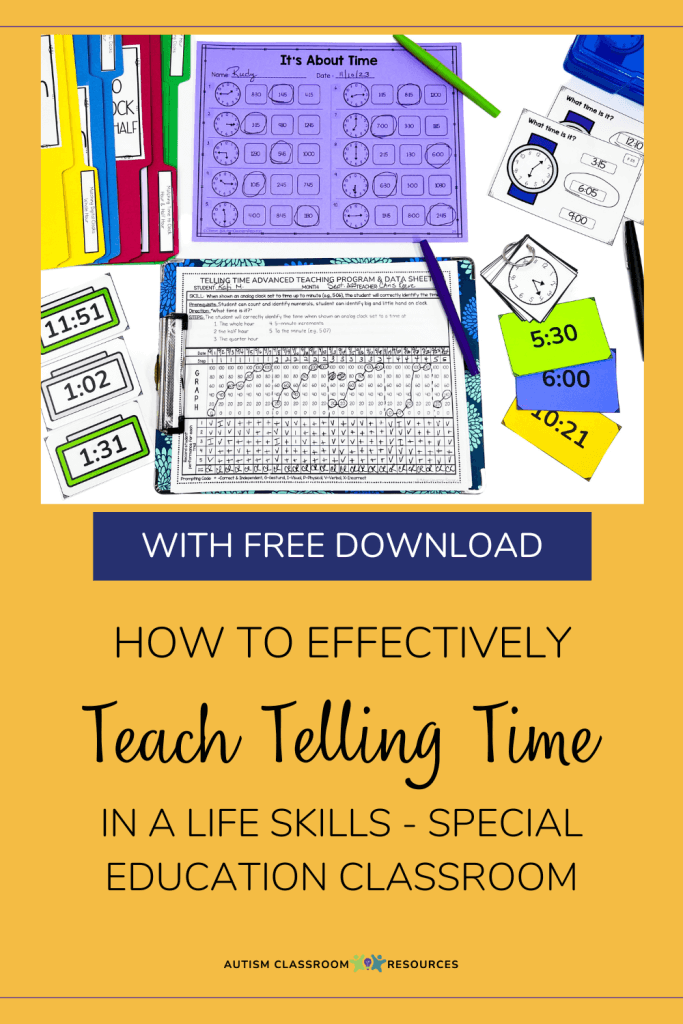
Over the years I’ve met many life skills teachers who struggle with how to effectively teach telling time to their students. Sometimes we fall back on presenting time materials more than the explicit instruction our students benefit from most.
Teaching telling time can be complex, though, in that we tell time in different ways: analog and digital. We use different time telling tools (e.g., watches and clocks). And some students will learn to estimate the time, learning the skill to the quarter hour for instance. While others will master telling time to the exact minute.
The Importance of Telling Time as a Life Skill
When we think about life skills, we often think about daily living skills, money skills, and teaching telling time. These are functional skills that all our students need regardless of their level of academic performance.
Telling time is a critical life skill because it impacts so many areas of our lives. Knowing how to tell time helps our students to know or understand
- time expectations are for a task, helping them to self-regulate and complete their work
- when they get to do something they want, helping them to know how long they have to wait for something
- how to be on time for class, for work, for appointments etc.
- how to schedule appointments effectively given a schedule
- shift from an activity schedule to a time-based routine or schedule
- and eventually, it can lead to learning time management.
Why Teaching Analog AND Digital Time is Important
Many times it feels easy to fall back on adapted devices for students to be able to tell time. Certainly digital watches are available in abundance now and often easier for telling time than an analog clock. However, I’ve been in a number of situations where my digital watch battery died (especially my smart watch) and all I had to tell time was an analog clock on the wall, in the airport or in a classroom. Knowing how to read the analog clock became an important skill at that point.
![How to Effectively and Efficiently Teach Telling Time [picture of teaching materials]](https://autismclassroomresources.com/wp-content/uploads/2024/02/Blog-Pictures-How-to-Effectively-and-Efficiently-Teach-Telling-Time-23605.jpg)
Barriers to Teaching Time Telling in Special Education
Telling time is one of those teaching topics that you can often find lots of practice materials, but sometimes they just aren’t meant for YOUR students. This is particularly true if you work with older students, so the second and third-grade time materials really don’t feel right for them, do you agree?
In addition, our students don’t learn telling time in the set period of time that typical students usually do. It’s not a unit you can teach for a few weeks and expect true mastery. Typically students in life skills classrooms need more explicit instruction and more practice with different types of materials to truly acquire and master the needed skills.
And that typically means they need more time and more materials to effectively learn how to tell time.
Start With Explicit Instruction: Using Task Analysis and Data to Teach Telling Time
Sometimes it’s easy to skip over the step of explicitly teaching how to tell time and skip directly to file folders and worksheets. And I’ll talk about the importance of those types of materials in the next section. But, teaching the mechanics of telling time is critical.
To do this, I use task analyses with gradually increasing steps of difficulty. In the Telling Time to the Hour Through Minutes: Analog & Digital Instruction Programs, I’ve included both the task analyses and graph-as-you-go instructional data sheets with the steps already laid out for teaching the different skills.

For those of you unfamiliar with task analyses, they basically take the goal of instruction and break it down into small components. Then you teach them sequentially. I’ve written more about task analyses here as well as shaping and chaining that are two strategies commonly used to teach with them.
Skills Involved in Learning Telling Time
By teaching students explicitly the 12 skills included in the instructional toolkit, they learn to tell:
- analog time to the hour and half hour
- analog time to the quarter hour
- analog time to 5 minutes
- analog time to the minute
- digital time to the hour and half hour
- digital time to the quarter hour
- digital time to 5 minutes
- digital time to the minute
They also learn to set a clock to:
- the hour and half hour
- the quarter hour
- 5-minutes
- the minute
Differentiating Instruction When Teaching Time Telling
Some students will learn well with larger steps, while others will need steps broken down into smaller ones. This is the importance of differentiation, as you know. And because most of us have a pretty varied case load, being able to adapt materials is really critical in instruction of any concept.

For instance, the Telling Time Toolkit pictured above is designed with 2 overarching programs that work well for students who progress quickly through steps with less practice. These programs include the 12 skills outlined above, each broken down into learning segments of time (e.g., telling time time to the hour, then telling time to the half hour, then telling time when set to each randomly).
However, for students who learn faster with less repetition, there are overarching programs that include each of those 12 skills as an individual teaching step, rather than a program of its own. If I’m not sure how to differentiate instruction for students, I typically start with these programs. But if my graph-as-you-go data isn’t showing that the student is making progress, then the steps are likely too big. Then it makes sense to drop down to the more detailed teaching programs.
Use a Variety of Materials to Teach Telling Time
Finally, once students acquire the skill in instruction, we need to generalize it throughout their day. One way we can do that is by using a wide variety of materials, like file folders, worksheets, and task cards.
![Teaching telling time with lots o practice materials like [pictured] worksheets, task cards and matching file folders](https://autismclassroomresources.com/wp-content/uploads/2024/02/Blog-Post-Telling-Time-Bundle-23605-4-1024x576.jpg)
In addition to generalize when we teach telling time, we can:
- Put times on the students’ schedules so they begin to connect activities to time
- Highlight times when reviewing the schedule for the day. I choose times that I know will be specific. For instance, we might not transition between centers exactly on time. But chances are good we show up to specials, recess and lunch in a timely manner.
- Discuss time in stories for when activities take place during literacy and morning meeting.
- Have students check the time and report it before doing helper jobs or write the time to sign in for a favorite activity. (This is also one of my fun ways to get them started on signing into job sites.)
Teach Telling Time with the Comprehensive Instructional and Practice Bundle
As I noted above, I’ve created the Telling Time to the Hour Through Minutes: Analog & Digital Instruction Programs specifically to help teachers with ready-made task analyses and data sheets. It includes the task analyses and data sheets I talked about above as well as flash cards (analog and digital) and clocks with moveable hands for instruction.
It also includes easily adaptable IEP goals for making sure that your teaching and your data collection or progress monitoring match up. I talk about this in my free Taming the Data Monster On-Demand Webinar–Sign up here.
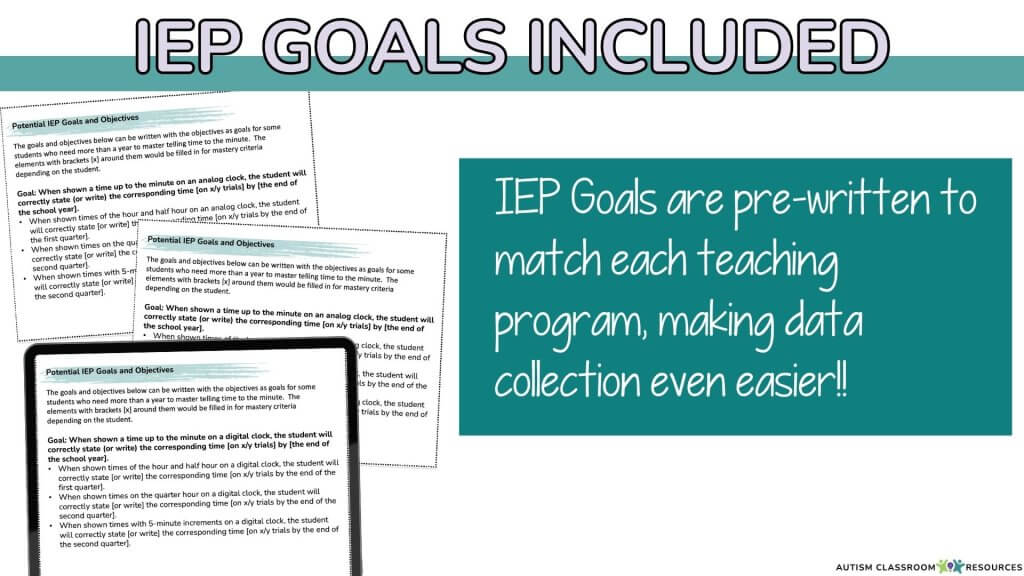
In addition, in the Comprehensive Bundle, I’ve included:
- File folder matching activities (97 binder pages) for students to practice reading the clock and matching to sample up to 5-minutes
- 218 multiple choice task cards for telling time to 5 minutes, differentiated from a free set to the hour up through 5 minutes.
- 230 scaffolded multiple-choice worksheets for the year, already differentiated and ready to print and use
And all include digital and analog options.
So, if you are looking for tools to teach telling time to your students, make it easy on yourself with all the tools you need to differentiate your instruction to meet the needs of your students.
Check out this comprehensive bundle below (or the individual products linked above). And grab your free Telling Time to the Hour Task Cards as well to get started!
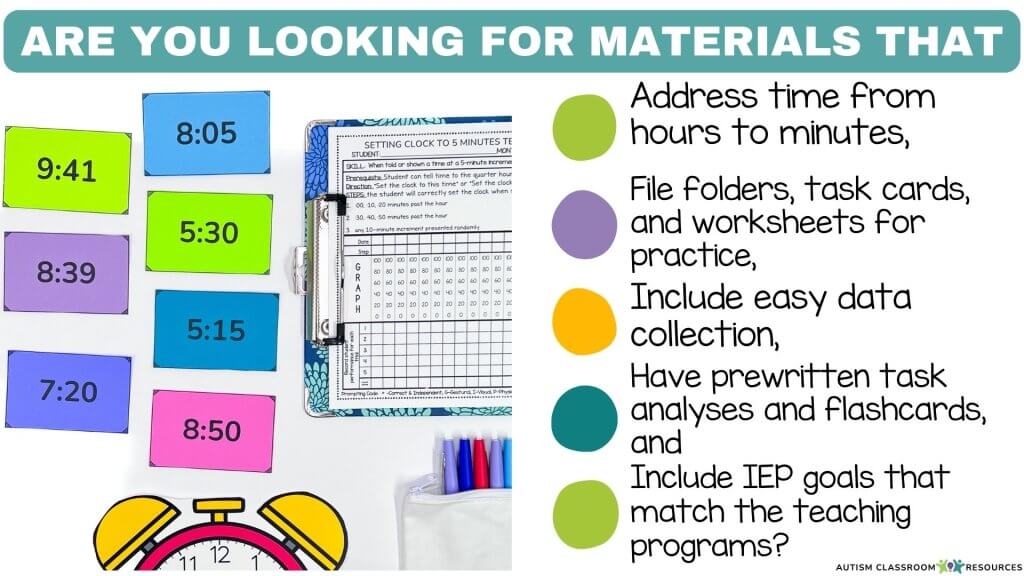
Grab Effective and Efficient Time Teaching Resources
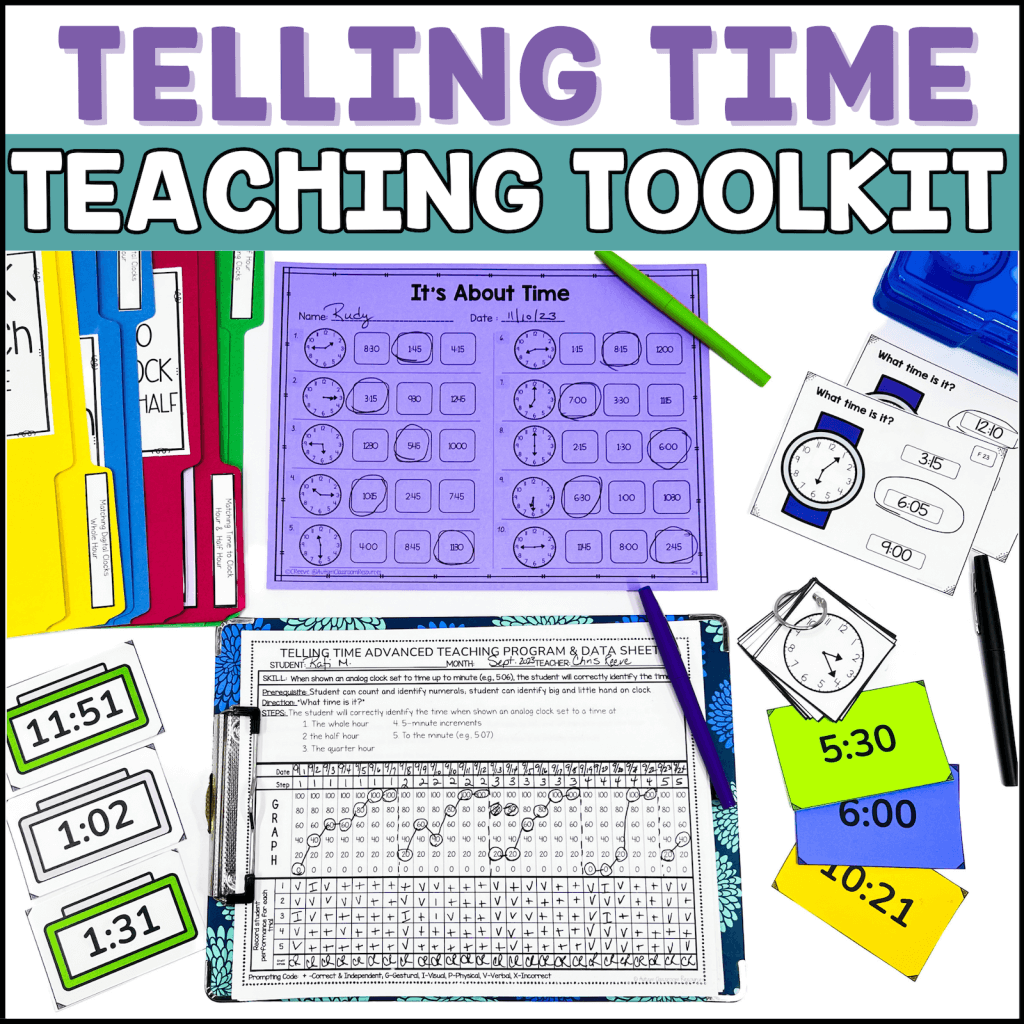
Everything you need for explicit instruction and task analyses (plus data collection) and generalization for teaching time in life skills classrooms.


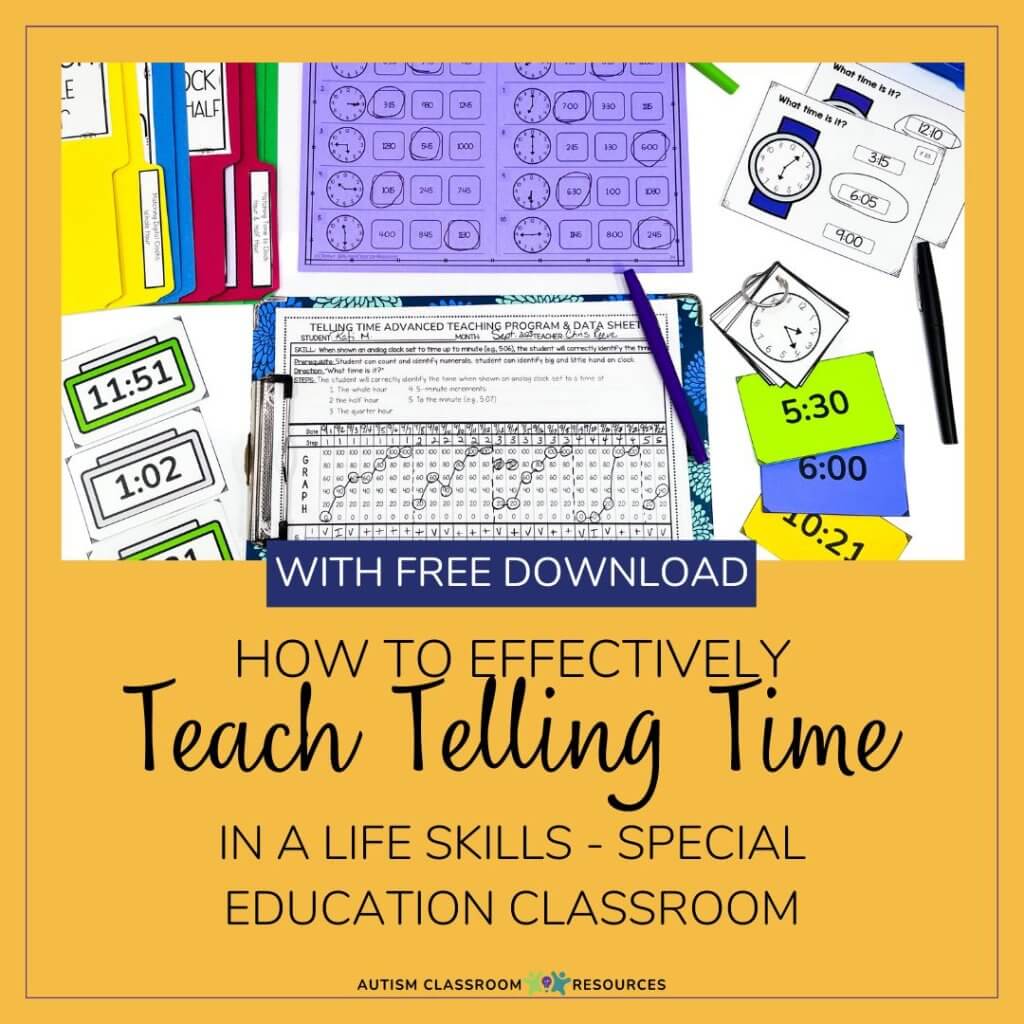
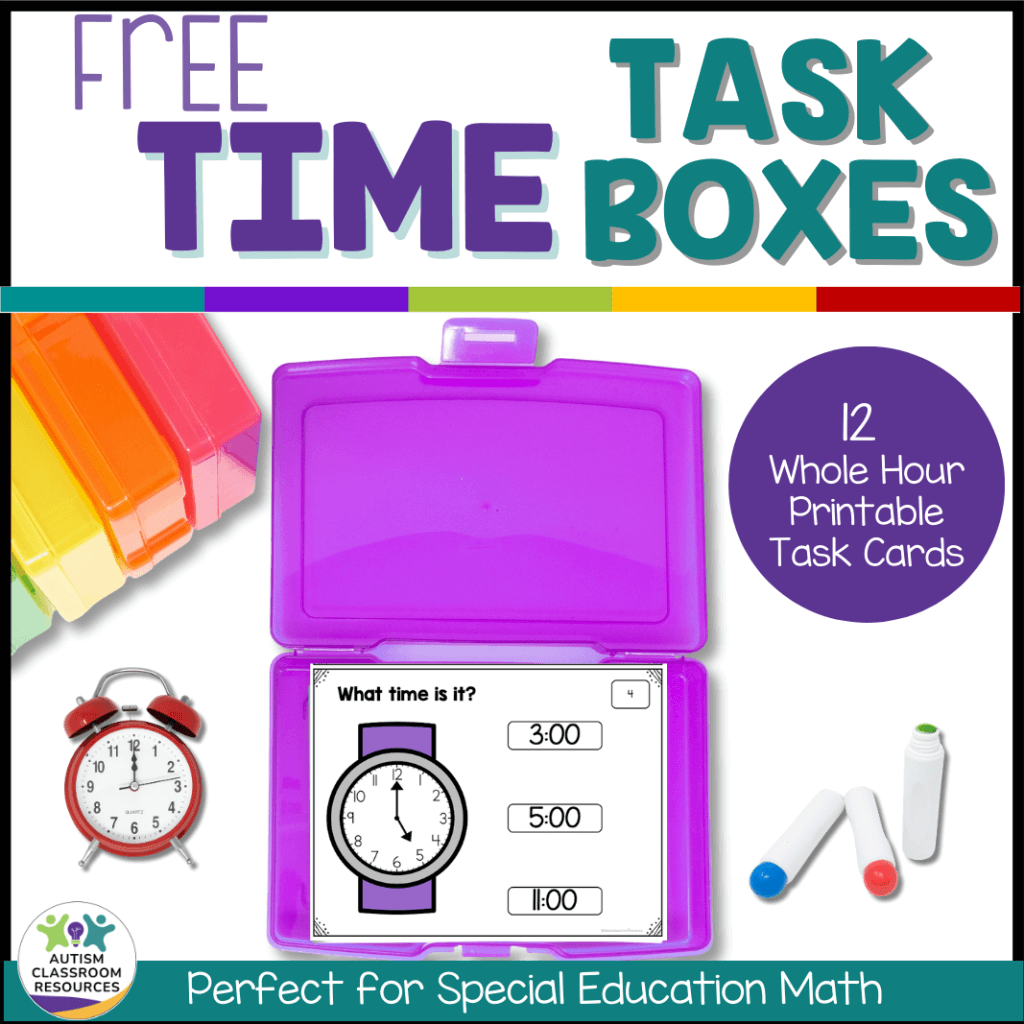
![Summer resources to help survive the end of the year in special education [picture-interactive books with summer themes]](https://autismclassroomresources.com/wp-content/uploads/2018/05/SUMMER-RESOURCES-ROUNDUP-FEATURE-8528-768x768.jpg)




